By Dr. Tony Michaels
from : NOAA Classroom Exploration of the Ocean Virtual Teacher Workshop
An in depth read on planktons for students from Sr.Secondary and undergraduate courses
I’m going to talk about plankton. I’m a plankton biologist-biological oceanographer. I got into it by accident but I’m fully hooked for the rest of my life in this. I’ll actually tell you the accident story. Mary Silver was my PhD advisor. She may look a little like the absent-minded professor and she often is, but she’s also very shrewd. And when I applied to go to Santa Cruz I applied to work in a completely different area with a completely different person. But she saw my application and she thought she had a better project for me to do and it was open ocean oceanography. She was department chair at the time so she stole my application out of the stack. Nobody else knew that I applied and I got accepted to work with somebody I had never seen or knew. I had never ever been out at sea overnight. I’d been on little short day trips close but never ever been out to the open ocean. Mary sat me down that first day and said “Look you can go somewhere else (I had a fellowship), but try this. You’re the right person, this is a great project, just try this.” It was working with a unique little group of plankton that nobody had really studied in a hundred years that she thought was really important. And I learned to think was really important. And it was a really fun introduction. I got myself on a ship a few months later, to see if I could hack it in February, off Monterey in fifty knot winds in 30 foot seas in a little 110 foot boat that the naval postgraduate school had, bouncing and bouncing. I didn’t get sick; I loved it and I have been a plankton biologist ever since.
I’m going to tell you a little about plankton. I have a passion for plankton and I’m going to tell you a few little stories about some of the things that these do. Some of it’s fairly general but some of it’s the interesting way the study of these organisms in the sea has been changing the way we look at the big elemental cycles in the ocean, the way the oceans handle nutrients, the way they handle carbon. The oceans are huge. The big scale elemental cycles. It doesn’t matter which organisms are out there. Is one plant just like another? Is one animal just like another? Or does it matter that a little plant is different than a big plant? A diatom is different than a coccolithophorid? I’ll go through some little stories about that how that puts it together.
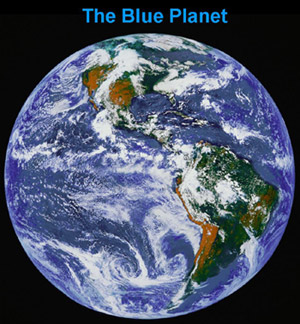
The fundamental reason I think this is important, and I have all kinds of reasons I can give, is this is the blue planet. 70% of our plant is the ocean. Most of that’s the deep ocean. The deep oceans are the largest biome in the world, a livable space where something routinely lives. This is the biggest space by volume in which organisms live. And so it’s a decent sized chunk of the world to take on if you want to study life on this planet or life in the sea.
So I care about plankton. I am going to try to give you reasons to care about plankton. But I am going to focus particularly on one big reason and that’s the global carbon cycle. We are going to look at the flow of carbon around the world on the globe and then in the ocean.
Does anyone know why we care about the global carbon cycle these days? What’s the big issue?
Global warming. You’ve got this gas CO2, carbon dioxide . As concentrations increase in the atmosphere it has the potential to warm the planet up and so we want to understand why does the atmosphere go up and why does the potential for warming the planet increase or change through time. To understand that we have to understand the big flows of carbon.
So let me just create a simple view of the world. It’s got land. It’s got an ocean. It’s got an atmosphere.
We’re going to start with people here. We’ve been taking this fossil fuel, carbon out of the ground. Where did that carbon come from in the first place? It’s dead plants and animals. Somewhere in the past somebody took some carbon dioxide and that somebody is a plant, linked it together to make organic carbon and stored some energy there. We then grabbed this stuff and pulled it out of the ground and we’re getting that energy back. So we’re breaking those chemical bonds. We’re getting that energy back, and when we do that we put that carbon dioxide back into the atmosphere. We do this at a rate of five and a half gigatons. Actually I had that earlier on. A gigaton is a billion tons of carbon. That’s going to be my little unit for the globe. I’ll still only talk about carbon for a little bit of this. But gigatons are billions of tons of carbon. Billions of tons of carbon. If you look at what we do, we pull this carbon out and we burn it. Billions of tons of carbon every year to the atmosphere.
We introduce five and half billion tons of carbon every year to the atmosphere. At the same time we take some trees; we chop them down and we burn them. And when we do, that that’s carbon in trees that goes back into the atmosphere as CO2. That’s another couple billion tons of carbon so about 7 billion tons of carbon.
But if you look at the atmosphere, we know unambiguously that carbon dioxide in the atmosphere is going up but it’s only going up three billion tons a year. So somehow half of the fossil fuel that we’re burning and the carbon we’re releasing by chopping down trees and burning them isn’t showing up in the atmosphere. So it’s got to be going somewhere else. This is this great conundrum. Where is this carbon going? Why isn’t the atmosphere going up twice as fast as it ought to given how much carbon we’re releasing?
So you go around and you look around and now you got living plants—not the ones we chopped down. And living plants grow and they take up carbon and then animals and bacteria use that carbon and respire it back to CO2 and there’s a balance there. It’s about 60 billion tons a year each way. But it’s actually 61 we think going in and 60 going out. So plants right now are taking up a little more carbon than the animals and bacteria are respiring on land. So the total amount of organic matter on land is getting bigger. Well there are two reasons for this. One is that as the carbon dioxide goes up in the atmosphere, it actually fertilizes plants on land. They have trouble getting carbon dioxide out of the atmosphere. The other is that we have been chopping down forests for a long time. If you look at a picture of the Eastern United States or Europe a hundred years ago there were no trees. We had chopped all those trees down and we used them to get firewood to heat our homes. We use them to build those homes and we had deforested huge chunks of the United States and huge chunks of Northern Europe. And then we found fossil fuels and we could do that without burning trees. So the trees started growing back. So those areas are reforesting now. When you drive around the East coast you see trees everywhere and those trees are adding carbon storing it in their wood. That’s increasing slowly the total amount of organic matter and it’s storing a little bit of carbon out of the atmosphere. And there is a little bit getting back into the land. It is kind of balancing. This is coming out off the tropics now. That’s up in the temperate zone. It’s kind of balancing that out.
But it is the oceans where the big trick is. The oceans exchange about 100 billion tons a year. So 100 billion tons comes out of the ocean, and 100 billion tons goes into the ocean. But it’s about we think 102 to 104 billion tons going in. It gets only 2%; it’s a tiny number compared to the whole size of the ocean.
But that is about the same as what’s going up into the atmosphere. And it accounts for the lion’s share of what we put in the atmosphere that doesn’t show up as an increased carbon dioxide. So if the oceans do this, twice as fast, so instead of going from 103, they go to 106 . We might not even be able to measure that small a difference. You can see it because it has been accumulating over hundreds of year. It is a tiny little change. The atmosphere stops going up altogether. If they stop doing this, the atmosphere goes up twice as fast. That’s why we want to understand this. So the oceans are saving us from this half of this debacle that we have done for ourselves. They are taking up half of the fossil fuel CO2 that we burn. And we don’t know why. It is a great mystery.
If you had asked anybody thirty years ago, if the oceans were capable of doing this, they would’ve said no. They should be in a nice equilibrium balance with the atmosphere. They should be no reason that the oceans take up extra carbon. When we look at why they do it, it is because the oceans have organisms in them that have tricks. And so what I want to do is talk about these organisms. This is the open ocean. This is the world’s largest biome. It is 60% of the surface of the earth. It is over 99% of “livable” volume.
The things that we are talking about here are the plankton. Plankton are drifters. They’re the things that can’t move a big distance compared to the currents that move the water around. Things like marlin and tuna can move huge distances compared to the currents. But anybody that can’t move very far compared to the currents, we call those plankton. They’re drifters. They’re stuck with whatever parcel of water that they find themselves in. Maybe they can move a few hundred meters. There is a whole class of them that live in the deep sea and come up at night, to eat and go back down. They move huge numbers of body lengths each night to feed. There is a whole bunch of things that these organisms do but they all share this capability of drifting with the water.
They come in a huge range of sizes. This is one of the broadest size spectrums anywhere in the world. Just among the plankton, you’ve got viruses, which are tiny fractions of a micrometer, incredibly small. The oceans are filled with bacteria and Archea another whole kingdom of life here. They are a couple of tenths of micron in size, infinitessimally small. And there are whole bunch of stuff in between that I’ll talk about a little bit. And then you’ve got some big stuff. And you’ve seen some of these big things. We had the talk last time about the jellies. They are weird things. They live in a world that doesn’t have surfaces. But I think they are the best organisms around. There are things called salps, all the jellies we talked about. There are even some protozoans that can be meters in size, little colonies of single celled animals that can be meters long. So you can have plankton things that can’t swim very far, but they get really large. And you’ve got whales that are also out there in the 10 meter size range. Huge ranges of sizes of living things out in the open ocean.
And there’s lots of them. Incredible numbers of these things. If you take a teaspoon of sea water, well, 5 mils, and you count all of the little living things in just a teaspoon, average teaspoon of seawater; you have about 100,000,000 viruses; 10,000,000 bacteria; 5,000 microalgae; 3,000 single cell animals- protozoans. In just a teaspoon, and there are a lot of teaspoons in the ocean.
So if you take all of those teaspoons and you add them up, the total volume in the ocean, you can calculate how many viruses and bacteria—these are all the naturally occurring things in the ocean.
These numbers just go on and on and on. It’s an incredible amount of life. There are way more plankton than there are stars in the universe. This is a massive amount of individuals but they’re all tiny. Little bitty things.
And if you want to compare it to humans… Say there are five billion people on the planet- how much seawater does it take to equal the number of people on the earth? The number of viruses in one cup of water; bacteria in one pint; microalgae in 265 gallons, protozoan in about 440 gallons. Lots and lots of things. Kind of a tough thing to do is counting them one at a time. You don’t go out there and census these things the way we try to count people in this country. You got to find abstract ways to study this huge diversity and huge abundance of organisms.
There is another trick with these organisms. In that they’re so small, that they’re smaller than the wave lengths of visible light. If you want to see something with visible light, and you are smaller than it, you can’t image it. We can only image things. The wavelengths of visible light is about a half of millimeter – half a micrometer. And so you can’t see these things that are fractions of a micron in size. There were a set of tools that were created about a decade ago, where we stain these organisms with little stains, so that they aren’t, we aren’t trying to image a little dot that’s really really small. We shine light on it and it shines light back of a different color. It is called fluorescence. And this was a magic breakthrough that happened about a decade ago or so ago, where all of a sudden when you put these on a microscope slide you shine one color light- blue light on it- they glow green light. And all of a sudden we can see them. This is a special thing that shows both viruses. There were millions and millions of these things. Completely changed our world view about how these things work.
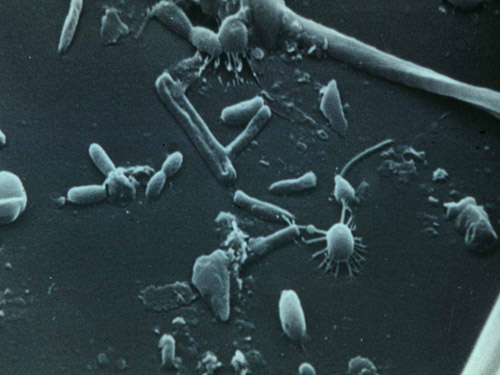
The other way you can see them is with an electron microscope. An electron microscope- has very small wavelengths you can really get structure- but you suck them down onto a filter and you dry them out. And what’s that (above)? Well that’s probably a bacteria- that’s probably some kind of thing- they’re pretty hard to tell what they are- you can get them in a lot of detail – it’s really hard to figure out what these things are -it is a real detection problem.
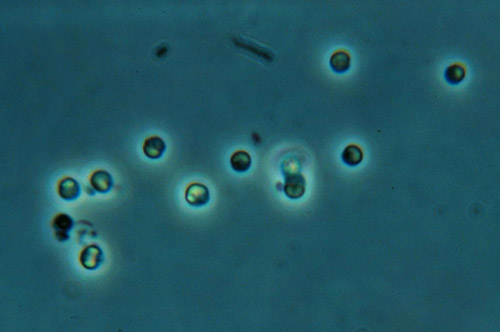
And then these (above) are big , a couple microns in size- and you can start seeing them with a light microscope- but again, what the heck is that? You know just little tiny dots- they have some flagella- you can count the flagella- you can maybe look what color they are and get some sense of what they are. But it has been very difficult.
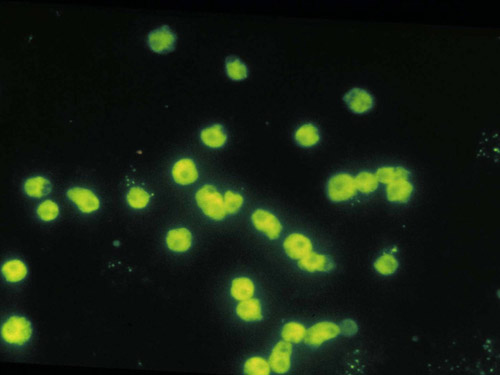
We have some fluorescent stains that are very specific to individual organisms. So you can use those to make a specific taxic row. But there’s been a revolution in all these little things. And that revolution is molecular biology. In the old days you look at them and look at them and look at them. Today you grind them up. You strip out their DNA, you sequence the DNA and all of a sudden you know who they were. You can even make little probes like this (above) where it attaches to a certain kind of organism and then you can say ahh that’s Fred, that’s Joe, that’s Mabel. And you can pick out what organisms are. So we are just right at the cusp of being able to parse out for all this little stuff that’s most of the life there-who it is. Except in the grossest sense. It is going to be an exciting revolution in the next decade as we start figuring that out.
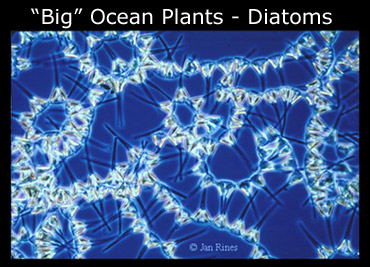
A type of diatom
Now you get bigger, and all of a sudden it gets a little easier. You know they have structure. Now big to me- it’s a hundred microns. So we are not talking about whales yet- and we might not ever in this talk. But in my talk, big is a few hundred microns, ok. All of a sudden you have these organisms with structure – they’ve got skeletons- they have shapes. And you can really look at them and identify what they are. You can know that this is a specific kind of ocean plant that has a siliceous skeleton.
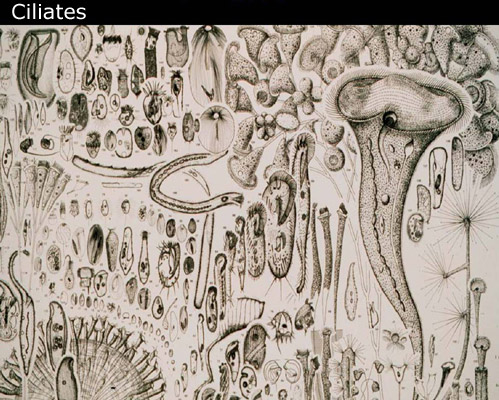
These are animals, little animal called ciliates (above). These are all from a single sample. A clever person with a microscope takes a single plankton tow and drew a picture of everything that they saw. This one kind of organism- ciliates- a single celled animal- and that’s all the ciliates they found in one sample. Incredible diversity of life. These are big enough to have structure. You can see what they are.
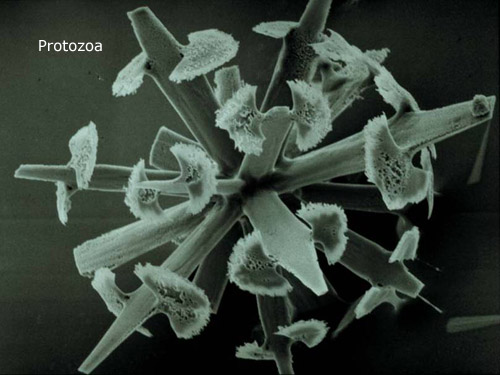
Then there are some other big organisms. Now these get to be millimeter sized– you can almost see them with your naked eye. This (above) is actually the skeleton of one of my little research areas –this little group of organisms that Mary Silver talked me into working on. But they get bigger. They have structure. You can identify what they are. So single celled animals can get up to a centimeter in size. You are talking about a big single cell but it is something you can see, you can work with.
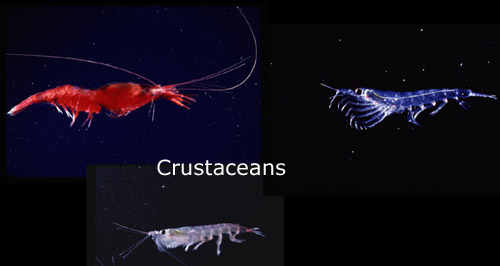
And then we get to real animals. And some of the classic real animals of the sea are the crustaceans (above) — these are like insects. These are euphausiids. I just like the pretty pictures- I thought a really quick story of who these things are. These are mostly euphausiids, and they are gorgeous animals. Some of them live in the deep sea. Some of them live up in the shallower areas. The deep sea- are the redder ones. You can see these are animals. These are real things are moving around. These are capture feeders. They go and grab things out of the ocean.
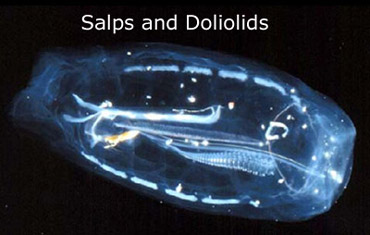
There is another kind of organism, which I’ll call Salps and Doliolids (right). These are related to jellies, but these are actually almost related to us. This is scary I think. The jellies we talked about last time are relatively primitive animals. These jellies, which are just gelatinous and gooey with some rigidity to the body. But these are almost vertebrates – these almost have a backbone they are chordates- clever little things. But we will come back to talk about them again in a minute. These are amazing little organisms. They filter feed. They slurp all water in and suck all of the particles out-make big poop. They are not ptenofores. Ctenophores are another one of the primitive groups. It’s in the early jelly groups. There’s ctenophores-comb jellies and then there’s the other jellyfish that we talked about last time-the cnidaria. These are completely different phyla—way out of the other end of the advanced spectrum. They’ve almost got a back bone.
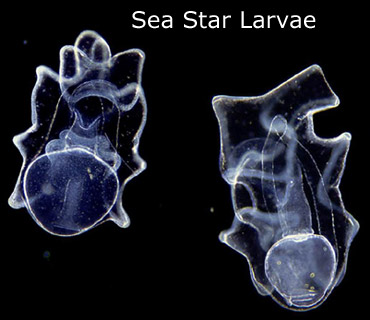
And you have also some things that are the larvae of things that live on land. So these are sea star larvae. So some of the things that live on land send their babies out in the ocean to fend for themselves for a few days or a few weeks or a few months and hope those babies get back to shore to grow. But while they are out there, they are being good plankton, they’re drifting with the water; they are eating and doing life.

And you got a few fish. You love fish can swim. But there are a bunch of fish that just don’t move very much. Some of the deep sea things; some of the larval baby fish.
We’ll get up into the fish, the real vertebrates, but just at the upper end of the spectrum.
That’s just a quick tour through some of the bugs. There are a whole bunch of them. I could spend weeks talking about plankton. You could all spend weeks talking. We love plankton. They’re beautiful; they are elegant; and they’ve done all these clever things to stay alive. But let’s talk about their life. Let’s just reduce life in the sea to some few simple elements. Cause ultimately I want to get back to the carbon cycle.
So if you’ve got a life; you’ve got a few things you got to do. You’ve got to get energy, store it in chemical bonds, make things out of the energy; you’ve got to find the raw materials you need and if you’re a plant there are inorganic nutrients you need or if you’re an animal, it’s in the stuff that you eat and you have to use that energy the raw materials together to make your body and make babies to make the next generation as you go along. OK. That’s your goal
These organisms don’t care about global biogeochemical cycles; they don’t care about the carbon cycles. All they want to do is make their next generation of themselves. And they all strive to do that. The net outcome of all that is that they move nutrients around and they change the way the world works.
It all gets down to some very simple things. Plants are primarily using the energy from the sun; they’re the first step in this and they take that energy and they capture it and they are storing it in chemical bonds. OK they take light energy and they turn it into chemical energy in chemical bonds. Photosynthesis, classic equation you’ve all seen.
Remember this fossil fuel thing; that’s where the fossil fuel came from. It’s just some plant, doing the step; it was just doing it fifty million years ago. And when you drive your car, you’re breaking that chemical bond; you’re getting the energy out to run your car. You’re burning sunlight that shone on the earth fifty million years ago. I think that’s cool; you know some plant fixed (made) that bond fifty million years ago. Some animal probably ate it and pooped and that poop built up somewhere and then got buried in rocks and pressure changed it into oil and we pulled that oil out, pulled a fraction out and we made gasoline. And then you break that bond and you get that energy out and that’s sunlight that shone on the earth fifty million years ago. I don’t know. I think that’s cool. I like plankton too.
OK. And plants can’t live on carbon alone so there’s all this other stuff that our bodies are made of. And so we call those nutrients– all the other stuff– — the stuff you might run out of is the stuff you also got to keep track of—nitrogen, phosphorous; and if you have a skeleton, calcium and silica, iron and many other things. Our bodies are made up of a whole ton of stuff. And we need all those bits. If any one of those goes wanting, it’s going to slow us down, it’s going to keep us from growing. So we want to make our bodies out of all the things it takes to have a good healthy body. Plants and animals in the sea are no different. So we need that energy. We need the materials and we call those materials nutrients.
And in the ocean there’s a kind of a trick that generally speaking, a lot of the organisms are pretty similar in what they are made of. They generally have about 106 carbon atoms for every 16 nitrogen atoms for every one phosphorous atom. And so you have this common composition of a lot of things. If you’re an animal, it means you are very similar to what you eat. If you’re a plant that means you’ve got to get a certain amount of CO2 and certain amount of nitrogen and a certain amount of phosphorous to make your body. And there’s a relationship between this.
So then if you’re an animal and eat things, this is another trick with ocean animals. This is very different than thinking about plants on land. You have to get food by eating it. You tend to eat things that are smaller than you are. Actually everything, well not everything, but I like to think almost everything in the ocean dies by being eaten by something else. What a way to go! That’s the natural pattern of this. It’s these food webs; everything eating everything else and you eat things that are smaller than you are. There is no caterpillar in the sea that’s grazing on a tree. You’re eating things that are about a tenth your size. OK. It makes it simple in some ways. And when they eat them, they then break some of those chemical bonds to get the energy back out, simply run the photosynthesis equation the other way because they need the energy. And they use the raw materials of the stuff in their prey to make their own bodies. And when you do that, you’ve got to burn some of it so you can’t use all of what you eat to make your own body because you broke a bunch of those chemical bonds to get the energy out. And that produces waste. I want to make two classes of waste. We’ve got poop and we’ve got pee.
OK. Why would I make a distinction between poop and pee as the two classes of waste in the ocean? Different forms of nitrogen; one has more nitrogen but there is nitrogen in both. But what’s another character of poop and pee that might be different? Solid and liquid. What’s the difference when you think of plankton between a solid and a liquid? Solids sink. Solids sink, yes and liquids don’t. Liquid wastes act like the rest of the plankton and float around with the plankton. Solid wastes sink out. And where is all the light in the ocean? Right up in the top. So if the nutrients get peed, they stay right up there where another plant that’s got light can use it. If the nutrients get pooped they sink out and are lost. And this is a real fundamental dichotomy. It’s either stripped out of the surface and then that carbon and nitrogen and phosphorous is lost from the very surface. It’s not available to those plants anymore. It’s also what else happens at the very surface of the ocean with carbon? Exchanges with the atmosphere.
So if you take the carbon away from the surface, it’s not there anymore to exchange with the atmosphere. If it’s peed, it stays there; it’s exchanging with the atmosphere. So this is how you get carbon away from the surface. Not because they wanted to. There’s no grand conspiracy of all these organisms getting together and saying “Let’s get some carbon out of the surface to keep that CO2 from going up.” They’re just having a life and one of the things that happens when you eat, is got to burn some of that food so you poop and you pee. The waste parts out and the poop sinks and the pee doesn’t. OK.
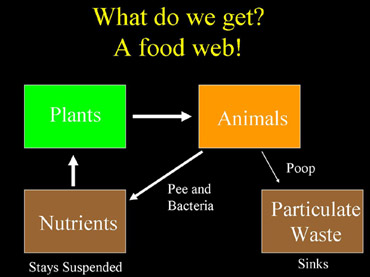
So now let’s talk about a food web. Let’s start with simple food webs and make it a little bit simpler. We can divide in a simple sense plants, animals, the nutrients that plant need. The animals eat the plants and each other. They release stuff. Some of it is directly peeing out nutrients. There’s actually bacteria that are doing a lot of this activity but I am going to skip that bacteria. And so they are all part of regenerating these nutrients in the sea. And they are all little suspended things so they act like pee. And then some animals poop. We’ll find there are plants that are big enough to sink when they die. And a few other things here. If some stuff that sinks out and some stuff that gets recycled in this plan.
This is all the biology that’s in a global carbon model in the ocean. When you hear about these modelers that are out there predicting the future climate of the earth. They’ve got an ocean in those models. That ocean has life in it and that’s all the life there is in that model. Class of plants and class of animals. And some fraction that says how much of what they eat gets pooped and how much of what they eat gets peed. OK. That does a pretty good job but is it good enough.
And that was the question I’ve worked on. Is it good enough to just have that simple biology or do you got to know whether those animals are big or small or this kind of animal or that kind of animal or big or small plants, this kind of plant, that kind of plant? And that’s what I work on. Does the structure of the community matter? You got tiny plants; you got larger plants. Tiny plants get eaten by tiny animals. Larger plants get eaten by larger animals. Tiny animals make little poop that can’t sink or they mostly make pee. Big animals can make big poop that can sink fast. And you got bacteria acting on the organic matter to change it to nutrients. All they’re trying to do is make a living. All they want to do is have sex and have babies. Pass their genes on to the next generation. There are lots of them; the dominant plants in the ocean are a micron or so in size. You got mid-size plants, say an order of magnitude bigger. And then you got big plants another order of magnitude bigger. Does anyone know what size things have to before they can start to sink? How big is big when it comes to sinking?About a hundred microns. About a tenth of a millimeter. If you’re that big you can kind of sink. If you are down here in these sizes, you can’t. So this stuff sinks; these things don’t, generally speaking.
And so everybody ends their life by being eaten and you get eaten by somebody bigger than you are. So let’s put some animals in here. We’ve got mid-sized animals eating the tiny plants. We’ve got big animals eating the mid-sized plants. And very big animals eating the very big plants. These things are now up to a millimeter sort of size. Every plant gets eaten by somebody bigger than they are.
And of course these animals don’t care. They’ll eat the other animals too. And so the big animals eat the mid-sized animals. The very big animals eat the big animals. And so you have a food web. OK You start moving material up this food web.
Every step of the way you are going to burn stuff as pee.

You’re going to burn stuff as poop. So all these things pee a little and all these things poop a little. Little things tend to make stuff that is mostly suspended, so it’s mostly pee. Big things have nice big poops that can sink really fast.
My Dad is an engineer. It was always a great disappointment to him that none of his children went into engineering. And he is a city planner type engineer and one of the big things he did was build sewage treatment plants. And so none of his kids did this. I’m the egg head. So engineers don’t necessarily think that going off to be a professor in a university is the best job you can do. And so here this egg-head son goes off to be a professor in a university, but at least I studied poop. It’s a little bit closer to the family business kind of thing. So he can respect that. But it was I have to say that I got the job here, one of my responsibilities on the island is to make sure our sewage treatment out there runs. We have a real sewage treatment plant. It was his proudest day one day when I called and said Dad “I’m having trouble with the treatment plant. Come on out here” and father–son down there in the bowels of the treatment plant checking it out. But it was a good step along the way of having a son that was sort of in the family business.
Stuff poops; stuff pees. Lot of recycling. You got structure; you got a lot of stuff happening right here
Every step of the way; every time you have one of these steps, you lose stuff because you have to get the energy out. And this is trophic transfer, trophic efficiency. And so the more steps you have the more stuff you lose. You can’t be 100% efficient. Even 30% efficient is big. And think about this. When we grow when we eat we want to be 0% efficient. I want to eat as much as I possibly can and not put on any weight. That’s not what these organisms are trying to do. They’re trying to put on a good amount of weight and they’re trying to make a lot of babies. So they want to convert as much of their food as they can. They want to get this energy out and there’s only so much they can carry into their own bodies. And so there’s this wrestling match and of course we are out on one end of it saying I don’t want to gain weight at all. But they can’t be 100% efficient; they can’t even be 30% efficient. They have to break those chemical bonds to get energy and when they break the bonds, you’re back to nutrients.
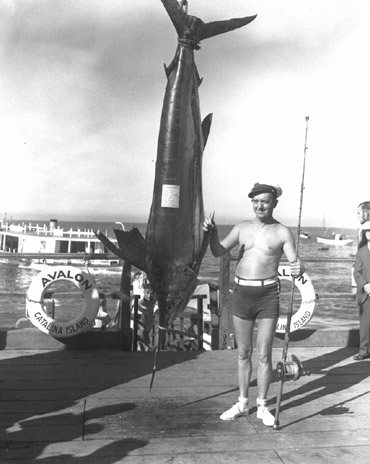
Now somewhere out there we got big things that live in the ocean, but there’s even bigger things that used to live in the ocean. Here’s a striped marlin. And they used to get really really big. Now what does it take? This is a huge organism. Remember everybody eats somebody smaller than them and I’ve been talking about stuff that are millimeters as big. And here you got these massive things. What does it take to make something that huge in the ocean?
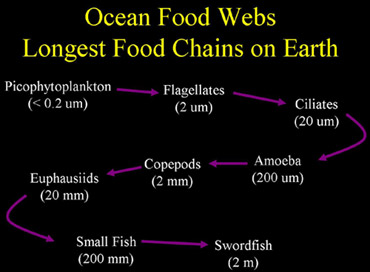
Oceans have some of the longest food webs you can imagine. This is a food chain, sort of picking out a logical feeding chain in that complex food web. Whereas what I had up on the board was just sort of the first few steps of this. You can start with those tiny plants that get eaten by these little animals then bigger animals. By little protozoa, the big protozoa and then get eaten by copepods, and euphausiids, and the small fish and the swordfish. You can go through lots of steps to make something and every step of the way you lose something
So say it’s 30% efficient. How much of that little tiny plant called picophytoplankton does it take to make a 1000 pound swordfish, something that we might eat at our table?
Four and half million pounds of plant material to make that 1000 pound swordfish, if it had to go through all those steps. Now that’s a lot of steps. I made that up to make it look long. Now that’s not the average steps.
On average there are about five steps in an open ocean food web where these big pelagic fish live. How many pounds does it take at 30% efficiency if you only have five steps?
That’s still 400,000 pounds of plants. It multiplies. It’s a multiplier because you multiply 30% times 30% times 30%. You just lose stuff really really fast.
What if it’s only 10% efficient; which is kind of a canonical number we used to use, that’s probably too low.
Then it takes a 100 million pounds to make a swordfish. So you get really big stuff. This is why you don’t have a lot of really big things out there in the ocean. It’s a very complex food group with a lot of steps from those little itty bitty plants up to something that is really really big.
If you want to have a lot of fish, you can look at ocean food webs. It depends how many steps there are in the food web, how efficient the steps are, and how productive the plants are. We live off an upwelling coastal zone. There are a lot of plants here but that doesn’t necessarily make a lot of fish if you got a long food web. We have short food webs. If you got a lot of plant production in very short food webs, our anchovies eat plants. One step you’re at a fish. Something eats the anchovies. Second step you’re at something big that you can eat. That’s a short food web; lot of productivity here because it’s an upwelling system. Go to the open ocean, start with itty bitty plants; lot of steps to get up there. We still harvest a lot of swordfish out of the open ocean but it’s draining the energy from a huge body of plants that are out there.
Now let us get back to the poop—the good stuff. Who cares about the poop? The trick with the poop, we’ve talked about this. It sinks away from the surface into the deep sea. It’s the dark deep sea, keeps it away from where the plants can grow. It takes carbon with it, about 40% of its carbon. What do we care about this carbon in the poop? And this gets back to the CO2 thing. It takes it away from the atmosphere. So if we go back to our story this poop is getting the stuff, when it’s right here it’s exchanging with the atmosphere. If you get it into the deep sea, it’s not.
Now the sea turns over so eventually it’s going to come back to the surface unless it gets buried in the mud, but it takes a long time. So if the plants are dumping more stuff deep in the sea we can pull carbon out of the atmosphere. And there is no reason the oceans have to be stable in this. And we think this is what’s happening. For some reason there are parts of this pump that are more active than they used to me, probably natural reasons and they’re pulling more carbon out. They could stop doing it.
About 10% of what comes out is carbonate. The carbonate’s tricky because the carbonate changes the ph of sea water. So when you store carbon in carbonates it actually makes more CO2 at the surface and increases the CO2 in the atmosphere. So it’s a tricky one. The carbonate doesn’t dissolve very fast so a lot of it gets to the sea floor and when it’s down there it gets buried, not so much in oil deposits; it’s inorganic material It’s a bone kind of thing—not bone- but it gets buried in the sediments, all these calcareous oozes, places where there have been a lot of animals and plants that have big calcium carbonate skeletons that have settled down, essentially made big layers of that in the mud in the bottom.
Now let’s look at this food web again. Here’s my food web again. The big food web. Lot of recyling. Some poop coming out. Lot of steps. There’s not a lot getting up here to the big things that cause material to sink.
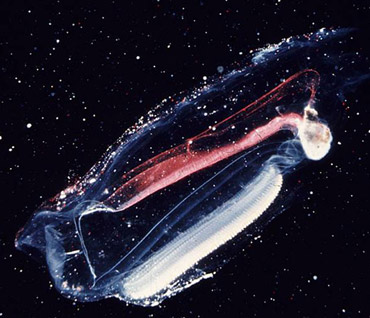
Let’s think about these salps. I think this is clever. This is one of nature’s little surprises that sort of snuck up and bite us on the rear end when we think we know everything about the ocean carbon cycle. You have these salps. This is another picture of a salp. They put a little dye in here to show you the filter-feeding basket. There’s a little bit of mucilage there and they pump water through that. All the particles stick on it and they roll it up into their stomach. They digest a certain part of it and they poop the rest out. Now these salps you know Little salps are about a centimeter. Fair number of salps are an inch or two. Then you got salpa maxima—sort of a nerf football sized thing. And so they’re big animals and they’re filter feeding under the smallest things there and they make big poop
And when they feed they’re eating everything. They’re eating all the little plants, the medium-sized plants, big plants, medium sized animal, big animals, bigger animals They just suck this all through the system into salps and they make hulking poops that sink to the bottom of the ocean these things sink a thousand meters a day. They get to the bottom in four days. They’re huge. So these guys short-circuited my whole food web. They took what the open ocean food web is like with lots and lots of steps and made it a really short food web. So all of sudden you get all of this material right up into something big and out it sinks. This is the big difference that we’ve got to figure out when you’re studying the carbon cycle. This is what you work on. How often does this happen? Because when this happens carbon leaves the surface. When these things aren’t there carbon mostly stays on the surface and gets recycled and maybe it goes down a little bit but then its nutrients come back up in the next few years. This is the kind of event that just transforms how much carbon comes out of the system.
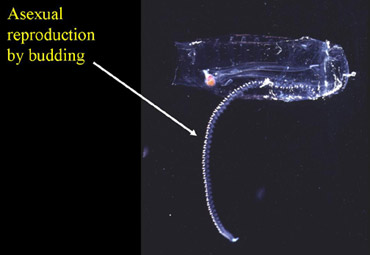
And these are tricky. Because salps have another trick. Remember we said that they were almost backboned animals. They’re almost like us but they can reproduce by budding. They have sex; with a backbone, they have sex; they have regular sex but they also have a way; it’s like a little pouch on the side of your body that you just have a little trail– a little peep hole that kind of pop off go off and spring free and become good little versions of yourself. Here you can see one of these. It’s a little chain of babies that they’re popping off asexually by budding. You can make babies really fast this way. You can make them as soon as you know that food is there. So food comes along and sometimes these things go nuts. And we don’t know why they go nuts. I’d really like to find out why they go nuts.
But I know what happens when they go nuts. . When they go nuts, there are just tons of them around. There are actually a beautiful set of cruises done for about a decade, actually it’s been done for about fifty years off the California coast. But there was a decade in the fifties where they took and they measured stations all the way from Baja up to the Oregon border-a nice spread of stations– and they collected samples and they counted all kinds of stuff and they counted salps. This is directly out of the CalCOFI atlases. It’s where I got the idea. But I had to go back to the original atlases and pull these old samples out.
What you can see here (below); you can’t see the numbers quite clearly-it’s about 500,000 animals per meters squared. About one per two liters. So in a volume of water that big, the dolioletta is a little one and the thalia is a bigger one. In two liters of water you got one animal all the way down 70 or 80 meters in the water column. Huge number of animals. The previous month there were none and the next month there are none and somehow in the month in between; whoof! You are not going to miss this. It’s not like the ships went around and just steered clear of every salp bloom as they were wandering around. These are huge expanses of ocean that have so many salps that when you tow a plankton net through the water the whole thing just comes up completely full. The water is socked full of these things. And they just grew up and went nuts. They took over; they filtered all of the plants out of this water. And the next month they are all gone. And when they’re filtering the water they are pooping like crazy and then when they are gone, where do they go? They had to have died. They probably starved themselves, filtered all that water clean and no where to go. And there is one observation from a submarine where somebody went down in a sub by accident in a place where there had been one of these, saw a seven inch thick layer of dead salps on the bottom of the ocean. Usually you measure sediment accumulation in millimeters a year, but a 7 inch layer of salp is just on the bottom.
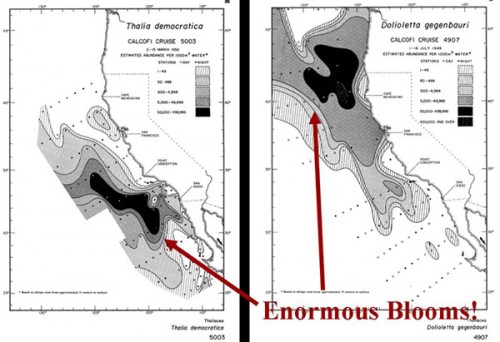
So how much carbon is that? You go through and do the calculations. You count (I can multiply) and you count how much carbon is in this bloom and how much carbon is in that bloom. This was one to two billion tons of carbon in one bloom. That’s a third to half of the carbon that increases in the atmosphere in a year. You have one more of those blooms –two of those blooms a year extra in the whole world and the atmosphere stops increasing in CO2. This is a tricky problem.
And there are only these two. I didn’t just pick these randomly. These are the only two instances of a bloom this big in the whole decade’s worth of data. But it doesn’t take very many. It’s just one little piece of coastline. There is a similar data set off Japan. Same thing-couple a decades. There’s similar data set off the North Atlantic-similar thing-a couple a decades. You can look through and you see how many would there have to be to stop global warming. In this area it’s one extra bloom every 30 years. That’s a really tricky thing to figure out. And they just appear and they appear because there are these relationships between them and the food they eat that all of sudden trigger them to grow like crazy.
The food keeps growing; they keep growing; they eat they eat and eat and they make these massive blooms. Most of the rest of the time they’re there but they don’t make these massive blooms. This is going to be one of the hardest things to figure out. Because these things can be most of the signal and they are very very hard to measure. But this is one of the challenges for the future, to take this kind of information understand what makes these rare big blooms. Nature surprises. Nature’s got this figured out. We’re the one’s reading the text books. They are out there trying to make babies. Nature’s figured this out. It’s our job to try to decode what nature’s doing. Figure out why these happen and do these matter. But the amount of carbon is such that they have to matter.
And there’s another clever part to this that becomes even scarier. Because when they did that they sucked a huge amount of carbon out of the ocean and that changes how much carbon goes into the ocean from the atmosphere. So when the salps bloom they change how much carbon is in the surface ocean and in the atmosphere. And that should change the climate. Now what triggered these things to grow in the first place is something that happened in the ocean and it might well have been a plankton bloom caused by upwelling or something else that’s caused by the climate system. The wind blows in a specific way or some trace element comes into the ocean and makes those plants go nuts just the right way for these animals to go nuts. And so the climate system probably changes the ocean in ways that might affect how salps can bloom, which then is going to change how much CO2, which is going to change the climate, which is going to change the ocean again. And this is a feedback system.
And this is again one of the biggest challenges in academia for studying the oceans. It’s places where something feeds back on itself. You saw that in the food web when we added the nutrients there. Now we can do that with the whole world. Because these things are having a big effect. They like feedback to having the very conditions that had that effect in the first place. Sometimes these are negative feedbacks. They’re like thermostats, where it changes one way for a while and then sort of counterbalances and changes the other way. Sometimes they’re a runaway where they can leave the ocean to cause CO2 to dramatically increase or dramatically decrease. As we look in the oceans we see more and more of these. When you find a process that deals with lots of carbon, nitrogen fixation, these salps; there’s a whole variety of these. They can make feedbacks themselves. And they can change the climate on their own and that feeds back to changing the conditions that let them live.
So let me finish up with a couple quick conclusions from that. Food webs matter for making fish. When you got lots of steps in the food web, you make small numbers of fish. Short food webs make lots of fish.
Food webs affect the amount of CO2 in the atmosphere. That’s the balance between poop and pee. How much goes down, how much gets recycled stays suspended in the water column.
Always be prepared for nature’s surprises. Nature’s got this figured out. We’re the one that are out there tinkering around the edges trying to decode what nature’s done. And there’s a lot of surprises out there for us. That’s why it’s exciting. That’s why we love plankton. There are so many more things out there yet to figure out.
Thank you very much.

Leave a Reply